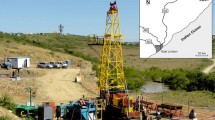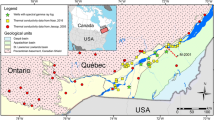Abstract
This paper addresses aspects of a baseline geothermal exploration of the thermally quiescent Elbe Zone (hosting the cities of Meissen and Dresden) for a potential deployment of geothermal heat in municipal heating systems. Low-permeable to impermeable igneous and metamorphic rocks constitute the major rock types at depth, implying that an enhanced geothermal system needs to be developed by creating artificial flow paths for fluids to enhance the heat extraction from the subsurface. The study includes the development of geological models for two areas on the basis of which temperature models are generated at upper crustal scale. The models are parameterized with laboratory-measured rock thermal properties (thermal conductivity k, radiogenic heat production H). The uncertainties of modelled temperature caused by observed variations of k and H and inferred mantle heat flow are assessed. The study delineates highest temperatures within the intermediate (monzonite/syenite unit) and mafic rocks (diorite/monzodiorite unit) forming the deeper portions of the Meissen Massif and, specifically for the Dresden area, also within the low-metamorphic rocks (slates/phyllites/quartzites) of the Elbtalschiefergebirge. Boreholes 3–4 km deep need to be drilled to reach the envisioned economically favourable temperatures of 120 °C. The metamorphic and mafic rocks exhibit low concentrations of U and Th, thus being advantageous for a geothermal use. For the monzonite/syenite unit of high heat production (~6 µW m−3) in the Meissen Massif, the mobilization of Th and U into the geothermal working fluid is assumed to be minor, although their various radioactive decay products will be omnipresent during geothermal use.




Similar content being viewed by others
References
Baria R, Baumgärtner J, Rummel F, Pine RJ, Sato Y (1999) HDR/HWR reservoirs: concepts, understanding and creation. Geothermics 28:533–552
Bea F (1996) Residence of REE, Y, Th and U in granites and crustal protoliths: implications for the chemistry of crustal melts. J Petrol 37:521–552
Behr HJ, Dürbaum HJ, Bankwitz P, DEKORP Research Group (B) (1994) Crustal structure of the Saxothuringian Zone: Results of the deep seismic profile MVE-90 (east). Z Geol Wiss 22:647–769
Bucher K, Stober I (2010) Fluids in the upper continental crust. Geofluids 10:241–253
Cabral Pinto MMS, Silva MMVG, Neiva AMR (2014) Release, migration, sorption and (re)precipitation of U during a granite alteration under oxidizing conditions. Proc Earth Planet Sci 8:28–32
Cuenot N, Scheiber J, Moeckes W, Genter A (2015) Evolution of the natural radioactivity on the Soultz-sous-Forêts EGS power plant and implication for radiation protection. In: Proceedings of the world geothermal congress, Melbourne, 2015
Degering D, Krüger F, Scheiber J, Wolfgramm M, Köhler M (2015) Radionuclide release in geothermal aquifers—the role of alpha-recoil. In: Proceedings of world geothermal congress, Melbourne, Australia 2015
Eggeling L, Genter A, Kölbel T, Münch W (2013) Impact of natural radionuclides on geothermal exploitation in the Upper Rhine Graben. Geothermics 47:80–88
Förster HJ (1999) The chemical composition of uraninite in Variscan granites of the Erzgebirge, Germany. Mineral Mag 63:239–252
Förster HJ (2000) Cerite-(Ce) and thorian synchysite-(Ce) from the Niederbobritzsch granite (Erzgebirge, Germany): implications for the differential mobility of Th and the LREE during alteration. Can Mineral 38:67–79
Förster HJ (2001) Synchysite-(Y)–synchysite-(Ce) solid solutions from Markersbach, Erzgebirge, Germany: REE and Th mobility during high-T alteration of highly fractionated aluminous A-type granites. Mineral Petrol 72:259–280
Förster A, Förster HJ (2000) Crustal composition and mantle heat flow: implications from surface heat flow and radiogenic heat production in the Variscan Erzgebirge (Germany). J Geophys Res 105(B12):27917–27938
Förster HJ, Rhede D, Hecht L (2008) Chemical composition of radioactive accessory minerals: implications to the evolution, alteration, age, and uranium fertility of the Fichtelgebirge granites (NE Bavaria, Germany). Neues Jahrb Mineral Abh 185:161–182
Förster HJ, Romer RL, Gottesmann B, Tischendorf G, Rhede D (2009) Are the granites of the Aue-Schwarzenberg Zone (Erzgebirge, Germany) a major source for metalliferous ore deposits? a geochemical, Sr–Nd–Pb isotopic, and geochronological study. Neues Jahrb Mineral Abh 186:163–184
Förster HJ, Förster A, Oberhänsli R, Stromeyer D (2010) Lithospheric composition and thermal structure of the Arabian Shield in Jordan. Tectonophysics 481:29–37
Fuchs S, Schütz F, Förster HJ, Förster A (2013) Evaluation of common mixing models for calculating bulk thermal conductivity of sedimentary rocks: correction charts and new conversion equations. Geothermics 47:40–52
Geiser P, Marsh B, Hilpert M (2016) Geothermal: the marginalization of earth’s largest and greenest energy source. In: Proceedings of the 41st workshop on geothermal reservoir engineering, Stanford University, Stanford, SGP-TR-209
Geissler WH, Kämpf H, Skácelová Z, Plomerová J, Babuška V, Kind R (2012) Lithosphere structure of the NE Bohemian Massif (Sudetes)—a teleseismic receiver function study. Tectonophysics 564–565:12–37
Hammer J, Eidam J, Röber B, Ehling BC (1999) Prävariszischer und variszischer granitoider Magmatismus am NE-Rand des Böhmischen Massivs. Z Geol Wiss 27:401–415
Linnemann U, Romer RL (eds) (2010) Pre-Mesozoic geology of Saxo-Thuringia. Schweitzerbart, Stuttgart
Mock JE, Tester JW, Wright PM (1997) Geothermal energy from the Earth: its potential impact as an environmentally sustainable resource. Ann Rev Energy Environ 22(1):305–356
Norden B, Förster A, Balling N (2008) Heat flow and lithospheric thermal regime in the Northeast German Basin. Tectonophysics 460:215–229
Pälchen W, Walter H (eds) (2008) Geologie von Sachsen. Schweizerbart, Stuttgart
Popov YA, Pribnow DFC, Sass JH, Williams CF, Burkhardt H (1999) Characterization of rock thermal conductivity by high-resolution optical scanning. Geothermics 28:253–276
Regenspurg S, Dilling J, Mielcarek J, Korte F, Schkade UK (2014) Naturally occurring radionuclides and their geochemical interactions at a geothermal site in the North German Basin. Environ Earth Sci. doi:10.1007/s12665-014-3306-6
Rybach L (1976) Radioactive heat production; a physical property determined by the chemistry of rocks. In: Strens RGJ (ed) The physics and chemistry of minerals and rocks. Wiley, London, pp 309–318
Seipold U (2001) Der Wärmetransport in kristallinen Gesteinen unter den Bedingungen der kontinentalen Erdkruste. Scientific Technical Report, STR01/13, GeoForschungsZentrum Potsdam, Potsdam
Somerton W (1992) Thermal properties and temperature-related behavior of rock/fluid systems. In: Developments in petroleum sciences, vol 37. Elsevier, Amsterdam, p 256
Tester J, Anderson BJ, Batchelor AS, Blackwell DD, DiPippo R, Drake EM, Garnish J, Livesay B, Moore MC, Nichols K (2006) The future of geothermal energy: impact of enhanced geothermal systems (EGS) on the United States in the 21st century. Massachusetts Institute of Technology. http://geothermal.inel.gov
Trumbull RB, Förster HJ, Rhede D (2010) REE–Y–Th–U-bearing accessory minerals and their contribution to the lanthanide and actinide trace-element budget in an anorogenic granite from the Erongo Complex, NW Namibia. Z Geol Wiss 38:145–166
Wenzel T, Mertz DF, Oberhänsli R, Becker T, Renne PR (1997) Age, geodynamic setting, and mantle enrichment processes of a K-rich intrusion from the Meissen massif (Northern Bohemian Massif) and implications for related occurrences from the mid-European Hercynides. Geol Rdschau 86:556–570
Wenzel T, Oberhänsli R, Mezger K (2000) K-rich plutonic rocks and lamprophyres from the Meissen Massif (northern Bohemian Massif): geochemical aspects for variably enriched lithospheric mantle sources. Neues Jahrb Mineral Abh 175:249–293
Acknowledgements
Our special thanks go to J. Dillenardt who conducted a substantial number of the thermal conductivity measurements and the thermal modelling in the framework of her master’s thesis. Part of this study was funded by Sächsisches Landesamt für Umwelt, Landwirtschaft und Geologie, Grant Nos. B247 and 090288069. P. Dulski and W. Seifert (formerly GFZ) provided valuable assistance during microprobe and LA-ICP-MS work. B. Norden (GFZ) provided support with the 2-D modelling. The paper profited from comments and suggestions provided by N. Balling (Aarhus) and M. Verdoya (Genoa).
Author information
Authors and Affiliations
Corresponding author
Electronic supplementary material
Below is the link to the electronic supplementary material.
Rights and permissions
About this article
Cite this article
Förster, A., Förster, HJ. & Krentz, O. Exploration of the enhanced geothermal system (EGS) potential of crystalline rocks for district heating (Elbe Zone, Saxony, Germany). Int J Earth Sci (Geol Rundsch) 107, 89–101 (2018). https://doi.org/10.1007/s00531-016-1429-6
Received:
Accepted:
Published:
Issue Date:
DOI: https://doi.org/10.1007/s00531-016-1429-6




